
Initial results of an aerial 1080 predator control operation show feral cats and possums have been reduced to such low levels they were undetectable for at least three weeks after the operation.
The 40,000ha operational area includes a large portion of the remaining pukunui breeding sites in the Tin Range and surrounding forest.
Department of Conservation southern South Island operations director Aaron Fleming said pukunui now had their best chance in years at raising a new generation of chicks.
"This spring marks the first time in recent memory we’re entering a breeding season filled with cautious hope and optimism," Mr Fleming said.
"Feral cats are the No 1 predator of pukunui. Every year, despite trapping, hunting and other ground-based measures, pukunui numbers were sliding closer to extinction.
"With a population of just 105, pukunui are far from out of the woods, but clearing out feral cats across this important habitat will help improve the odds of survival and population growth for these ‘under-birds’."
A network of more than 300 trail cameras was set up to monitor introduced predators before and after the 1080 operation. So far, Doc had gathered and analysed more than 400,0000 images to measure numbers of feral cats and possums.
Mr Fleming said the results received so far were clear.

"While this is encouraging, our cameras have picked up plenty of feral cats roaming outside of the control zone and over time, they will reinvade.
"Our camera network will monitor the reinvasion, and we will see if the operation covered enough ground to enable a successful breeding season as part of the Pukunui Recovery Project.
"Our rangers are continuing to run an extensive trapping network to provide an extra layer of protection."
The available data also showed no negative impact on the kiwi population, as expected, Mr Fleming said.
Hundreds of thousands more images were still to be processed from cameras set up to monitor rats, along with three more weeks’ worth of cat images.
The pukunui aerial 1080 operation was led by Doc with support from Zero Invasive Predators (Zip).
Mr Fleming said Zip also undertook an eradication trial targeting three species of rats across 6500ha within the pukunui operational area to inform Predator Free Rakiura.
Trail cameras were also being used to measure the results of the eradication trial, and there were about 1.5 million images to process, mostly by eye, to identify and differentiate between the three different rat species.
In the meantime, Doc rangers were surveying for pukunui nests at multiple breeding sites across Stewart Island/Rakiura. They had found at least seven nests so far, Mr Fleming said.
"We’re thrilled to be starting this breeding season on such a positive note," he said. — Allied Media












